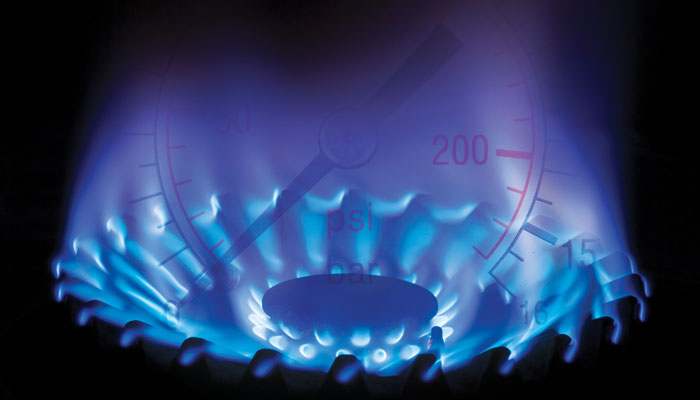It is a well-known and accepted practice to perform a leak test on all new propane installations. However, to ensure the continued safety of existing propane installations, the importance of performing a leak test during all interruptions of service cannot be over-emphasized.
An interruption of service is any time that there is not enough pressure for the appliances to operate. An interruption of service can be when regulators are changed, a tank is changed out, an “out of gas” situation, or any time the tank valve is turned off.
The National Fuel Gas Code [NFPA 54] is an excellent source for information on this subject. The text below is reprinted from the 2012 edition and spells out the leak testing requirements. Follow these rules, and always check with the local authority having jurisdiction for other requirements.
8.1.5 Detection of Leaks and Defects.
8.1.5.1 The piping system shall withstand the test pressure specified without showing any evidence of leakage or other defects. Any reduction of test pressures as indicated by pressure gauges shall be deemed to indicate the presence of a leak unless such reduction can be readily attributed to some other cause.
8.1.5.2 The leakage shall be located by means of an approved gas detector, a noncorrosive leak detection fluid, or other approved leak detection methods. Matches, candles, open flames, or other methods that provide a source of ignition shall not be used.
8.1.5.3 Where leakage or other defects are located, the affected portion of the piping system shall be repaired or replaced and retested.
8.2 Piping System Leak Check.
8.2.1 Test Gases. Leak checks using fuel gas shall be permitted in piping systems that have been pressure tested in accordance with Section 8.1.
8.2.2 Before Turning Gas On. Before gas is introduced into a system of new gas piping, the entire system shall be inspected to determine that there are no open fittings or ends and that all valves at unused outlets are closed and plugged or capped.
8.2.3* Leak Check. Immediately after the gas is turned on into a new system or into a system that has been initially restored after an interruption of service, the piping system shall be checked for leakage. Where leakage is indicated, the gas supply shall be shut off until the necessary repairs have been made.
While the code specifies when a leak test must be performed, it does not say how to do the test. NFPA 54 2012 does list three methods in Annex C.3, but the Annex is not part of the code. There are four basic methods of conducting this leak test using propane as the pressure source. The first is at the tank valve, the second is downstream of the second stage regulator, and the third is between the first and second stage regulators. The fourth method is at the vapor meter, if one is installed. Because of the various types of vapor meters, that type of leak test won’t be reviewed here.
For detailed instructions on how to perform all of the different types of leak tests, refer to the Propane Education and Research Council’s CETP course “Placing Vapor Distribution Systems and Appliances into Operation.” You can find it at www.propanesafety.com.
Leak Testing
Briefly, the steps for completing the most common types of leak tests in propane system are as follows.
At the tank valve, the service valve is closed and a 0-300 psi pressure gauge is installed between the service valve and the inlet of the first stage regulator. The service is opened to pressurize the system, and then closed. Enough pressure is released to lower the gauge reading by 10 psi.
If the reading stays the same for 3 minutes, the system can be assumed to be leak free. If the reading increases, the service valve is not turned off all the way, or is leaking through, and should be replaced. If the reading decreases, that is an indication that there is leak in the system.
Testing downstream of the second stage regulator is done using a water manometer, an electronic manometer, or pressure gauge that measures inches of water column (w.c.) in a port after the outlet of the second stage regulator. In this case, after the system is pressurized, the pressure is bled down to 9 inches w.c. and held for 3 minutes. As with the test above, an increase in pressure indicates a leaking service valve and a decrease shows a leak in the system.
For a test between the outlet of the first stage regulator and inlet of the second stage regulators, a 0-30 psi gauge is installed in the line between the two regulators. In this case, the pressure is reduced by 5 psi and observed for three minutes. A pressure increase shows a leaking service valve or decrease readings show a leak in the system.
Use Detector to Locate Leak
No matter which method is used, if the test gauge shows a pressure decrease, there is a leak or leaks that must be found, repaired, and retested before the system can be put into service. Use a combustible gas detector or leak detection solution to locate the leak. Never use any type of open flame or other ignition source to find a propane leak. Do not operate any electric switches. Use a safety flashlight to help find the leak(s).
Run the leak test again after repairing any leaks. Once the test holds pressure for 3 minutes, it is safe to place the appliance into operation.
Once a standard testing method is decided upon, a leak test is a relatively simple procedure to perform. After practicing a few times in the field it becomes second nature. In addition to being part of the required code, it is a necessary practice to ensure a leak-free installation and the safety of our customers.





